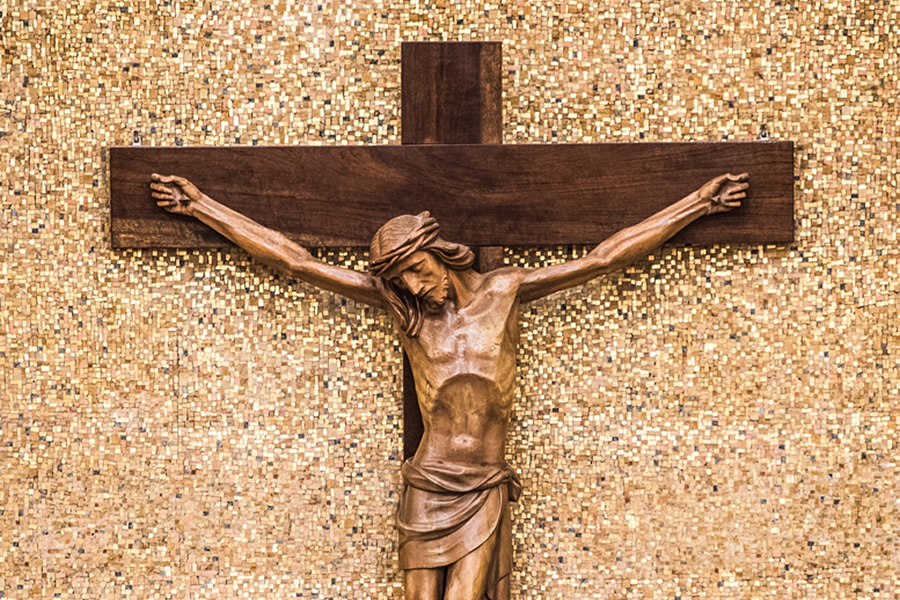
Initiation
by Rev. Gabriel Baltes, O.S.B. | 03/23/2025 | A Message from Our PastorDear Parishioners,
“Lent,” the word used to name the current liturgical season in which we are immersed, was most likely derived from an old Germanic word that meant “to lengthen.” It is a fitting word for this time of year as we watch daylight lengthen and nighttime shorten. The word, therefore, came to be synonymous with spring. Once Easter became an annual celebration for Christians, as well as, the major occasion when the church initiated its new members into the Christian community, the weeks of spring preceding Easter, became known as Lent. These Lenten weeks, which gradually turned into months and sometimes years, marked the period of preparation for the candidates of initiation who were called “Catechumens.” They were also called “the Elect,” because they had been elected by the bishop as those who would receive the Sacraments of Initiation that included: Baptism with water in the name of the Trinity, anointing with oil that, will eventually be called “Confirmation” or “Chrismation” (after the word “chrism” – which was the oil used for this ritual anointing), and reception of the Eucharist.
This threefold initiation rite, which was only celebrated once a year on the vigil of Easter, was also the first time these new Christians were permitted to publicly pray the Lord’s Prayer and receive the Kiss of Peace. The latter was an actual kiss on the mouth, first by the bishop and then the rest of the community. An additional symbol that, early on, got woven into this all night Initiation ceremony was the white garment in which the newly baptized were clothed. This symbolized rebirth and immortality and was worn for the full week after Easter. It was removed on the following Sunday – “The 8th Day” that was designated the Dominica Albis – “White Sunday.” (The number 8 was also symbolic connoting the dawning of the new and final age ushered in by the Resurrection of the Lord Jesus.) From this brief and skeletal summary of early Christian Initiation, it is evident that the rich theological meaning of this experience got communicated through the human senses by the dramatic use of ritual actions and the generous incorporation of material elements such as water, oil, cloth, bread and wine – hence the sacramental character of our Christian faith.
Once Christianity became a legally recognized religion of the Roman Empire after 313 AD with the “Edict of Constantine,” people entered the church in massive numbers. It was advantageous to be a Christian and eventually the adult population of Western Europe was Christianized. It was no longer possible, or necessary, to celebrate the elaborate initiation rites from the early church. Instead, the baptism of infants became normative with the sacraments of Confirmation and Eucharist being celebrated later when the child was of the age of reason and better able to understand the meaning of these rites. This had a direct impact on the Lenten Season which evolved from being a time of preparation for baptism to a penitential period – a sober time to repent of one’s sins so that Easter could be celebrated with greater joy and renewed exuberance.
The focus for this season now became the cross. Christians meditated on the passion of Christ’s suffering and deepened their own understanding of how participation in the cross of Jesus was experienced in their personal lives. The Stations of the Cross became a popular devotion along with a widespread and strict adoption of penitential practices such as fasting and/or abstinence from ordinary realities such as food, drink, sleep and luxuries items like sugar and animal fat. Forms of entertainment were curtailed, weddings prohibited, and any activities that evoked happiness and laughter were eliminated from people’s regular routine. For many, Lent became a 40 day period of hardship and self-denial deemed necessary in order to acquire a deeper appreciation of God’s merciful love.
With the liturgical reforms of the Second Vatican Council, Lent was restored to its original purpose as a time of conversion and preparation for adults who would be initiated at the Easter Vigil. The catechumenal period that was organic to the early centuries of church was recovered and implemented in parishes with great enthusiasm. Now called “The Order of Christian Initiation of Adults” (OCIA), this process of spiritual and intellectual formation is not only essential for those seeking membership in the church, but is also beneficial for those who are already members. As the latter assume the roles of catechists, sponsors and facilitators for the OCIA, they become re-invigorated in their Catholic faith as they learn or re-learn church teachings that are fundamental to who we are as followers of Jesus.
If you know of anyone who may be interested in learning more about the Catholic faith or becoming a member of the church, please reach out to them and encourage their curiosity. You may refer them to our parish OCIA coordinator, Matthew Krumdrick, who is always happy to meet with such individuals and help them discern where the Holy Spirit, may be calling them. As for our parishioners who might be looking for an additional supplement to their Lenten practices, I would encourage a visit to the link that connects our church and school. I have recently completed a project I began some time ago of arranging and identifying various crosses and crucifies that I acquired over the years. This collection demonstrates how the cross of Christ has been interpreted and uniquely portrayed over the centuries by different cultures of people and why it has been, and continues to be, the defining image of Christianity.
Blessings,
Rev. Gabriel Baltes, O.S.B.
BACK TO LIST